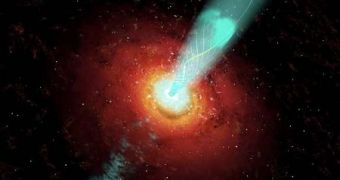Black holes have captured the imagination of scientists, movie producers and common folk over the years, because of their amazing traits and structures, and also due to the fact that they are unique in their own regard. There is nothing else in the Universe that resembles a black hole, or that can absorb and trap light. Additionally, these structures are the only ones that astronomers believe can generate some of the brightest lights that ever existed, as plasma jets, cosmic rays and gamma-ray bursts, Space reports.
Though no one can say for sure, most likely black holes form when massive stars reach the end of their burning cycle. Under their own gravitational pull, the core of the former stars collapses on itself, or implodes, into an ever-smaller, ever-denser region of space. Eventually, the core collapses to an area of infinite density and gravity, but with zero volume. This point in space is known among astrophysicists as a singularity. It pulls so hard on surrounding matter that even photons traveling amazingly fast are trapped inside the black hole, and are no longer able to continue their journey.
Before the original massive star implodes and its core begins to collapse, the outer layers of the star's atmosphere are violently expelled in its surroundings, a phenomenon that came to be known as a supernova. After the black hole is formed, it becomes unnoticeable, in that no probe we could possibly send out there would be able to return. It also begins to pull so hard on everything around it that it, in fact, modifies and warps space-time into an infinite curve. This is one of the main reasons why photons going inside cannot ever escape.
While the core of these structures remains dark at all times, hence the name, its surroundings do not. In fact, the areas around some black holes are terribly active, manifesting massive electrical and magnetic fields. Interactions between these “wild” fields and gas or dust produce the large amounts of radiation that are characteristic of the formations. One good example are gamma-ray bursts (GRB), which are very short and very intense flashes of high-energy light, originating most commonly in the early Universe. They are the most luminous things that have ever been recorded.

 14 DAY TRIAL //
14 DAY TRIAL //